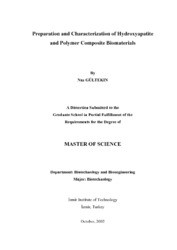Please use this identifier to cite or link to this item:
https://hdl.handle.net/11147/3708Full metadata record
| DC Field | Value | Language |
|---|---|---|
| dc.contributor.advisor | Tıhmınlıoğlu, Funda | - |
| dc.contributor.author | Gültekin, Naz | - |
| dc.date.accessioned | 2014-07-22T13:52:12Z | - |
| dc.date.available | 2014-07-22T13:52:12Z | - |
| dc.date.issued | 2002 | - |
| dc.identifier.uri | http://hdl.handle.net/11147/3708 | - |
| dc.description | Thesis (Master)--Izmir Institute of Technology, Biotechnology, Izmir, 2002 | en_US |
| dc.description | Includes bibliographical references (leaves: 116-121) | en_US |
| dc.description | Text in English; Abstract: Turkish and English | en_US |
| dc.description | xiv, 128 leaves | en_US |
| dc.description.abstract | In the thesis, the preparation and characterization of polylactide-Hydroxyapatite(HA) composite films for biomaterial applications have been studied. The effects of number of parameters such as polymer type, HA loading, surface modification and its concentration on the mechanical, thermal microstructural and hydrolytic degradation properties of the composites were investigated. Four different types of polymers, Poly (L-lactide)(PLA1), 96/4 L-lactide,D-Lactide Copolymer (PDLA1), Poly (L-Lactide)(PLA2), and 67/23 Poly (L-Lactide-co-D,L-Lactide)(PDLA2), have been used. In this study, PolyLactide-HA composite films have been prepared by solvent-casting technique. The HA powder was synthesized by precipitation technique. Interfacial interactions between HA and polylactide polymer were modified to improve filler compatibility and mechanical properties of the composites by surface treatment of the HA with two different silane coupling agents; 3-aminopropyltriethoxysilane (AMPTES) and 3-mercaptopropyltrimethoxysilane (MPTMS) at three different concentration. Silane treatment indicated better dispersion of HA particles in the polymer matrix and improvements in the mechanical properties of the composites compared to the untreated HA loaded polylactide composites. Tensile test results showed that the maximum improvement in the mechanical properties of the composites was obtained for the PLA composites containing 1 wt % aminofunctional silane treated HA and 0.5 wt % mercaptopropyltrimethoxy silane treated HA for PDLA composites. Scanning electron microscopy studies also revealed better dispersion of silane treated HA particles in the polymer matrix. Thermal degradation kinetics of the composites was investigated and it was found that addition of HA into polymer matrix decreased the thermal degradation temperature and also slowed down the degradation rate. In this study, the hydrolytic degradation of poly (L-Lactide)(PLA), poly (L-Lactide-co-D-Lactide) (PDLA) and their hydroxyapatite (HA) loaded composites (10-50-w/w %) were investigated in simulated body fluid (SBF) at 37 0C and at pH 7.4 by in vitro static testing. Using different techniques, namely weighting to quantify water absorption monitored the hydrolytic degradation and weight loss, scanning electron microscopy (SEM) to observe morphological changes occurred at the surface of the films over time. At the end of the 150 days, only 12.5 wt % and 9.5 wt % of weight PLA1 and PLA2 were lost respectively. Degradation of the copolymers was faster than PLA1 and PLA2 and weight loss data of PDLA1 and PDLA2 were found to be nearly same with 17.5 wt % and 17 wt %, respectively. The changes of pH on all polymer were stable at 7.4, because of simulated body fluid indicates buffer solution properties. Degradation rate of PLA and PDLA composites containing 10 wt % HA decreased, and also water absorption of these samples increased. Weight loss decreased approximately from 12 wt % to 5 wt % and water absorption increased from 10 wt % to 13 wt % for PLA composites containing 10 wt % HA. The change of microstructural properties of obtained composites has been determined in simulated body fluid as a function of time. It was found that the surface of polymer composite films was coated with the calcium phosphate layer. This coating was increased with HA loading and ageing time. | en_US |
| dc.language.iso | en | en_US |
| dc.publisher | Izmir Institute of Technology | en_US |
| dc.rights | info:eu-repo/semantics/openAccess | en_US |
| dc.subject.lcc | TP248.65.P62 G85 2002 | en |
| dc.subject.lcsh | Polymers--Biotechnology | en |
| dc.subject.lcsh | Polymeric composites | en |
| dc.subject.lcsh | Biomedical materials | en |
| dc.subject.lcsh | Hydroxyapatite | en |
| dc.title | Preparation and Characterization of Hydroxyopatite and Polymer Composite Biomaterials | en_US |
| dc.type | Master Thesis | en_US |
| dc.institutionauthor | Gültekin, Naz | - |
| dc.department | Thesis (Master)--İzmir Institute of Technology, Bioengineering | en_US |
| dc.relation.publicationcategory | Tez | en_US |
| dc.identifier.wosquality | N/A | - |
| dc.identifier.scopusquality | N/A | - |
| item.cerifentitytype | Publications | - |
| item.languageiso639-1 | en | - |
| item.openairetype | Master Thesis | - |
| item.openairecristype | http://purl.org/coar/resource_type/c_18cf | - |
| item.fulltext | With Fulltext | - |
| item.grantfulltext | open | - |
| Appears in Collections: | Master Degree / Yüksek Lisans Tezleri | |
Files in This Item:
| File | Description | Size | Format | |
|---|---|---|---|---|
| T000148.pdf | MasterThesis | 3.1 MB | Adobe PDF |  View/Open |
CORE Recommender
Page view(s)
204
checked on Apr 14, 2025
Download(s)
98
checked on Apr 14, 2025
Google ScholarTM
Check
Items in GCRIS Repository are protected by copyright, with all rights reserved, unless otherwise indicated.